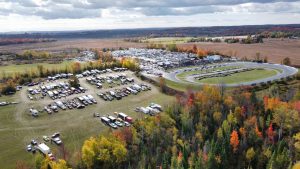 Situated in the heart of cottage country, Peterborough Speedway is located immediately west of Peterborough, Ontario. It is within 1.5 hours of Metropolitan Toronto. Peterborough draws attendance from the upper part of the Golden Horseshoe and 401 corridor extending from Toronto to Cornwall, highway access is via 401, 7, 28 and 115.
Situated in the heart of cottage country, Peterborough Speedway is located immediately west of Peterborough, Ontario. It is within 1.5 hours of Metropolitan Toronto. Peterborough draws attendance from the upper part of the Golden Horseshoe and 401 corridor extending from Toronto to Cornwall, highway access is via 401, 7, 28 and 115.
Peterborough Speedway’s 1/3 mile high speed paved oval resides on a picturesque site. Peterborough Speedway is Canada’s fastest 1/3 mile paved oval due in large part to its high banked sweeping corners. In the racing community the speedway is know as a drivers track. The spectator facilities at Peterborough Speedway can accommodate over 6,000 spectators for racing events at the oval. Spectator amenities include two food concessions with a pub style menu featuring everything from Jalepeno Burgers to our famous fries. Seating ranges from general grandstand seating to air-conditioned comfort in our 3 story VIP tower. The speedway boasts one of the very best lighting systems allowing the hosting of televised events at night. The racetrack averages thirty (30) race events per year, making it one of the busiest racing venues in Canada. It is one of the most versatile short tracks in existence capable of handling the entire spectrum of motorsports divisions from Super Late Model Stock Cars to Can-Am Midget sprint cars. This short track offers the thrill of motorsports in a very intimate setting. It is truly and outstanding entertainment experience
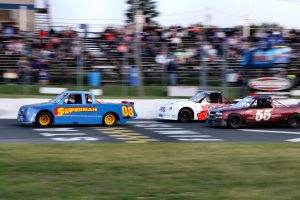 Peterborough Speedway formerly know as Westgate Speedway opened for the first time on Sunday May 28, 1967. Feature winners for that opening day were Don Greer in Late Model and Rich Harris in the Hobby division. Many Pinecrest regulars were in attendance that day including Vic Parsons, Phil Zampino, Gord Dolphin and Ray Gullison.
Peterborough Speedway formerly know as Westgate Speedway opened for the first time on Sunday May 28, 1967. Feature winners for that opening day were Don Greer in Late Model and Rich Harris in the Hobby division. Many Pinecrest regulars were in attendance that day including Vic Parsons, Phil Zampino, Gord Dolphin and Ray Gullison.
Wheelspin News reported that the track was built at a cost of $70,000. The original owners were John Plunkett, Bob Boynton, Harley Coons and John Van De Bor, all from the Peterborough area. Wheelspin News also reported that the track was “the first in Canada to use a soil-cement base, 18 inches deep and surfaced with two-and-a-half inches of asphalt”.
There was a large Pinecrest influence in the first year of operation. In addition to the large contingent of Pinecrest regulars, former Pinecrest announcer Woody Howard was the Westgate track manager and doubled as announcer. The pits were located in the infield, also like Pinecrest. The track ran the same Late Model rules as Pinecrest as well.
Westgate hosted a 75-lap International on August 13. It drew some of the top Late Model drivers in the province including Norm Lelliot, Doug Warnes, Jack Cook, Jim Hallahan, Vic Parsons, Earl Ross, John Clapham plus Americans Ed Howe and Bob Sennecker. Lelliot won the race.
The first season wrapped up on October 9 with Doug Warnes as the first Late Model champion. Terry Dickinson won the most features in the Hobby division.
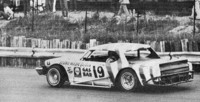 Westgate kicked off the 1968 season on May 11 as the first track in the area to open. The season opener was a Peterborough Kinsmen Club charity event. The Kinsmen took over as ticket staff and corner flagmen. All the proceeds from the event went to the Kinsmen. The drivers donated their winnings and only raced for trophies.
Westgate kicked off the 1968 season on May 11 as the first track in the area to open. The season opener was a Peterborough Kinsmen Club charity event. The Kinsmen took over as ticket staff and corner flagmen. All the proceeds from the event went to the Kinsmen. The drivers donated their winnings and only raced for trophies.
Westgate had some changes for their second season. The race night was switched to Saturday night. This eliminated the Pinecrest drivers as Pinecrest also raced on Saturday. The focus was now on the local drivers. The track added a 6 Cylinder division and renamed both of the regular divisions. The Late Models were now called the Overhead division and the Hobbies became the Flatheads.
Tragedy struck Westgate on July 8. During the Powder Puff race, the leader came out of turn four and lost control. She slid over the embankment protecting the infield pit area and landed in the pits, striking Chris Hurley of Agincourt. Hurley died at Peterborough Hospital that night.
Bob Moxon was the 1968 Westgate Overhead points champion while Claude Harness was the 6 Cylinder champion. The newspaper did not report on the Flathead champion at Westgate.
The 1969 season saw plenty of action on and off the track with accusations of rough driving, driver suspensions, pit fights (that sometimes included fans) and complaints about the quality of the clean-up crew and the flagging.
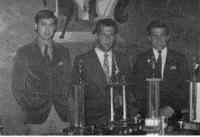 Westgate Speedway’s points champions were Earl Parsons in Overhead, Dave Lynch in Flathead and Art Robinson in 6 Cylinder.
Westgate Speedway’s points champions were Earl Parsons in Overhead, Dave Lynch in Flathead and Art Robinson in 6 Cylinder.
At the start of 1970 Westgate Speedway was sold to Brian Aitken of Toronto in April. Aitken held a pre-season drivers’ meeting that left the drivers optimistic that the track would be managed better than in previous years. It was promised that the drinking and fighting would be stopped and violaters would be punished.
Aitken’s resolve was tested early in the season. Tiny Walker was suspended for one year due to an on-track incident with Fred Glanville that saw Glanville’s car wrote off. This incident led to a pit fight that saw Ron Robinson being kicked out as well. Walker was allowed back after only a few weeks by a vote of the drivers. Robinson was back racing by the end of July as well.
Westgate hosted a 60-lap International for Diamond class cars on July 29. Barrie Speedway drivers took four of the top six finishing positions including winner Jim Vitkil. Another 60-lap Diamond Invitational was held on August 26. This time it was won by a Westgate regular, Gord Wallace. Both Diamond Invitationals were run on Wednesday nights.
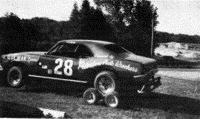 Aitken had a rough first year as owner of Westgate. In addition to the previously mentioned suspensions, Earl Parsons and Art Robinson were given a one-week suspensions for rough driving on August 29. There was a Diamond class drivers’ strike on September 5 over the suspensions to Parsons and Robinson. A meeting was held the following week but it was reported that it solved nothing. Zippy Zimmerman usually wrote the Westgate article for Wheelspin News and he never held back in his thoughts. In his season wrap-up article he mentions a number of issues: illegal cars being allowed to race, over-use of the black flag which led to single-file racing because everyone was afraid to make a move, constant shuffling of the officials including 5 different starters and a general lack of maintenance of the facility. Furthermore, he discusses the poor attitude of management toward the drivers. He claimed that track management referred to the drivers as “small town bums”. The drivers were told that they weren’t needed and the track could “import” drivers from out of town.
Aitken had a rough first year as owner of Westgate. In addition to the previously mentioned suspensions, Earl Parsons and Art Robinson were given a one-week suspensions for rough driving on August 29. There was a Diamond class drivers’ strike on September 5 over the suspensions to Parsons and Robinson. A meeting was held the following week but it was reported that it solved nothing. Zippy Zimmerman usually wrote the Westgate article for Wheelspin News and he never held back in his thoughts. In his season wrap-up article he mentions a number of issues: illegal cars being allowed to race, over-use of the black flag which led to single-file racing because everyone was afraid to make a move, constant shuffling of the officials including 5 different starters and a general lack of maintenance of the facility. Furthermore, he discusses the poor attitude of management toward the drivers. He claimed that track management referred to the drivers as “small town bums”. The drivers were told that they weren’t needed and the track could “import” drivers from out of town.
The 1970 season was the end for the first era of multiple tracks in the Peterborough area. Bell City closed early in the 1970 season and Cedar Circle did not open for 1971. Out of the six tracks that were operating in 1968, only Westgate survived to see a 1971 season. Zippy Zimmerman’s Wheelspin News column in May 1971 discussed the demise of the tracks. There was a rumour that several parties wanted to purchase the Bell City Speedway property, with one wanting to turn it into a “hippie haven” (it was 1971, remember). Zimmerman mentioned that there were rumours of threats of lawsuits relating to Cedar Circle.
Westgate would have the market to itself for almost twenty years. The opening of Mosport Speedway, north of Bowmanville, in late 1989 and its first full season in 1990 impacted the track (re-named Peterborough Speedway by this time).
